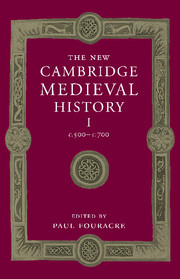Book contents
- Frontmatter
- Introduction: the history of Europe 500–700
- 1 The later Roman Empire
- 2 The Barbarian invasions
- 3 The sources and their interpretation
- PART I THE SIXTH CENTURY
- PART II THE SEVENTH CENTURY
- PART III THEMES AND PROBLEMS
- 20 The Jews in Europe 500–1050
- 21 Kings and kingship
- 22 The Mediterranean economy
- 23 The Northern Seas (fifth to eighth centuries)
- 24 Money and coinage
- 25 Church structure and organisation
- 26 Christianisation and the dissemination of Christian teaching
- 27 Education and learning
- 28A Art and architecture of western Europe
- 28B Art and architecture: the East
- List of Primary sources
- Bibliography of secondary works arranged by chapter
- Index
- Frontispiece"
- Plate section"
- Map 3 Gaul/Francia in the sixth and seventh centuries"
- References
24 - Money and coinage
from PART III - THEMES AND PROBLEMS
Published online by Cambridge University Press: 28 March 2008
- Frontmatter
- Introduction: the history of Europe 500–700
- 1 The later Roman Empire
- 2 The Barbarian invasions
- 3 The sources and their interpretation
- PART I THE SIXTH CENTURY
- PART II THE SEVENTH CENTURY
- PART III THEMES AND PROBLEMS
- 20 The Jews in Europe 500–1050
- 21 Kings and kingship
- 22 The Mediterranean economy
- 23 The Northern Seas (fifth to eighth centuries)
- 24 Money and coinage
- 25 Church structure and organisation
- 26 Christianisation and the dissemination of Christian teaching
- 27 Education and learning
- 28A Art and architecture of western Europe
- 28B Art and architecture: the East
- List of Primary sources
- Bibliography of secondary works arranged by chapter
- Index
- Frontispiece"
- Plate section"
- Map 3 Gaul/Francia in the sixth and seventh centuries"
- References
Summary
Coinage in the Roman world in the early fifth century consisted of a multi-denominational system in gold, silver and bronze. By the eighth century the coinage of western Europe was entirely of silver essentially in one denomination, the thin broad Carolingian penny. The change from a classical to a medieval coinage was radical, but the way in which it came about was neither sudden nor dramatic. It was a gradual process of transformation and evolution. This chapter will trace those developments from the earliest Germanic coinages of the fifth century to the introduction of the silver penny in the late seventh century, at which point the story is picked up in the second volume of the New Cambridge Medieval History.
The late fourth and fifth centuries saw the movement and resettlement of the peoples of central and eastern Europe on a scale that is unprecedented in historical times. Most of the tribes that settled within the former Roman Empire and established new Germanic states had at some stage acted as mercenaries for or concluded treaties with the emperor, which instilled in them a degree of respect for imperial authority, albeit a precarious one. They would have obtained substantial amounts of coin, mainly gold, as mercenaries, in tribute and as plunder, which gave them experience in dealing with money, even if they had not struck coins of their own before moving into the Empire. This was, no doubt, a factor in encouraging the continuity of circulation and minting that we find in most of the newly established Germanic kingdoms.
Keywords
- Type
- Chapter
- Information
- The New Cambridge Medieval History , pp. 660 - 674Publisher: Cambridge University PressPrint publication year: 2005
References
- 5
- Cited by



